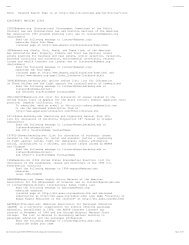BIEDERMANN MOTECH GMBH and Depuy Spine, Inc, Plaintiffs
BIEDERMANN MOTECH GMBH and Depuy Spine, Inc, Plaintiffs
BIEDERMANN MOTECH GMBH and Depuy Spine, Inc, Plaintiffs
You also want an ePaper? Increase the reach of your titles
YUMPU automatically turns print PDFs into web optimized ePapers that Google loves.
(Sheehan Decl. para.para. 29-33; Mossinghoff Decl. para.para. 11-32.) For example, Allez argues that Judge<br />
Harrington's finding, subsequently affirmed by the Federal Circuit, that "compression member" had a<br />
specific meaning in the medical device arts was based on thin evidence. (Mossinghoff Decl. para.para. 31-<br />
32.) Judge Harrington's finding was based on dictionary definitions outside the medical device field (the<br />
definitions related to the fields of architecture <strong>and</strong> aircraft engineering), <strong>and</strong> the definitions may have had an<br />
altogether different meaning than that called for in the '678 patent: a member being subjected to force rather<br />
than a member applying force. (Order of Jan. 17, 2007, at 14.) Allez also points out a change in the claim<br />
language during the prosecution of the patent (Allez Op. Br. at 20), provides evidence on the way that the<br />
term "compression member" is used in patent claims in the medical device arts (Allez Op. Br. at 20-23), <strong>and</strong><br />
argues that it is inconsistent with established jurisprudence to find that "compression member" is not a<br />
means-plus-function limitation. (Allez Resp. Br. at 14-20.)<br />
In effect, Allez argues that it should not be bound by an adverse ruling caused by allegedly subst<strong>and</strong>ard trial<br />
advocacy in the Medtronic case. (Allez Resp. Br. at 16 n. 6.) But regardless of whether Allez's arguments<br />
are persuasive, they are foreclosed. Claim construction is an issue of law <strong>and</strong> after due consideration the<br />
Federal Circuit has addressed this exact same issue in a previous case. Therefore, the Federal Circuit's<br />
holding is dispositive. See Markman v. Westview Instruments, <strong>Inc</strong>., 517 U.S. 370, 391, 116 S.Ct. 1384, 134<br />
L.Ed.2d 577 (1996). "Compression member" is not a means-plus-function limitation.<br />
The second question is how the phrase "compression member" should be interpreted. Again, because the<br />
Federal Circuit has ruled in this area, the interpretation of the claim limitation at issue must be consistent<br />
with the Federal Circuit's opinion. This task is somewhat difficult for reasons explained below.<br />
To start with, the Federal Circuit was addressing a different issue, whether "compression member" is a<br />
means-plus-function limitation. (Order of Jan. 17, 2007, at 14.) While the Federal Circuit's analysis suggests<br />
aspects of a definition for the term "compression member," it is not clear that the Federal Circuit intended<br />
that its analysis be plucked wholesale from its opinion <strong>and</strong> dropped into a definition for the term<br />
"compression member." The Federal Circuit stated, "The claims <strong>and</strong> the specification unmistakably establish<br />
that 'compression member' refers to particular structure. The claim language demonstrates that the<br />
compression member must fit inside the cylindrical opening <strong>and</strong> be of sufficient size to exert a force on the<br />
screw head, which implies structure." <strong>Depuy</strong> <strong>Spine</strong>, <strong>Inc</strong>. v. Medtronic Sofamor Danek, <strong>Inc</strong>., 469 F.3d 1005,<br />
1023 (Fed.Cir.2006).<br />
The main reason that it is unclear whether the analysis was intended to be used as a definition is that the<br />
analysis in large part relied upon dependent claims. Generally speaking, it is inappropriate to incorporate<br />
limitations of a dependent claim into a parent claim during claim construction. Curtiss-Wright Flow Control<br />
Corp. v. Velan, <strong>Inc</strong>., 438 F.3d 1374, 1380-81 (Fed.Cir.2006); Liebel-Flarsheim Co. v. Medrad, <strong>Inc</strong>., 358<br />
F.3d 898, 909-10 (Fed.Cir.2004). See also Pl. Op. Br. at 23 (arguing that it is inappropriate to limit the term<br />
"compression member" as used in claim 1 to having a spherically shaped portion on the underside, as the<br />
limitation is stated in dependent claim 3). Therefore, it would not be appropriate to define the term<br />
"compression member" narrowly merely because certain dependent claims add specific limitations to how a<br />
compression member would fit into the medical device. In particular, it would seem incorrect to limit the<br />
"compression member" recited in claim 1 to compression members which "fit inside the cylindrical opening<br />
<strong>and</strong> [are] of sufficient size to exert a force on the screw head." See <strong>Depuy</strong> <strong>Spine</strong>, 469 F.3d at 1023. Claim 1<br />
says nothing about a cylindrical opening in the receiver member, <strong>and</strong> claim 1 says nothing about the<br />
compression member fitting inside the cylindrical opening. Claim 1 reads as follows:






